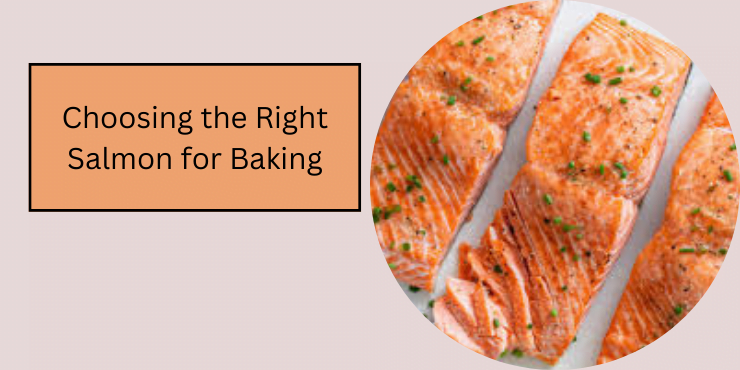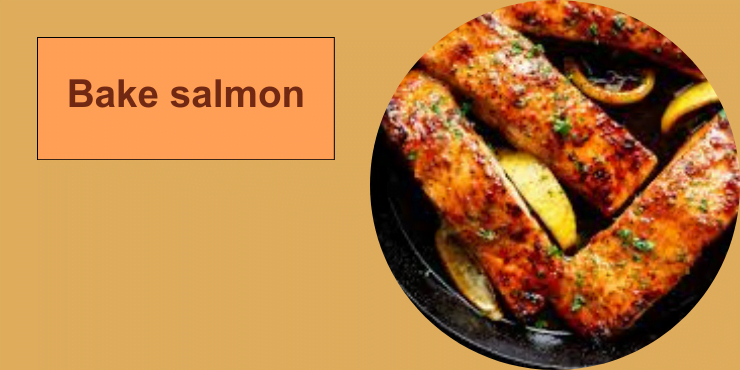Table of Contents
Bake Salmon is not only delicious but also incredibly nutritious, packed with omega-3 fatty acids, protein, and various vitamins and minerals. One of the best ways to enjoy this flavorful fish is by baking it. Baking salmon is easy, versatile, and results in moist, tender flesh with minimal effort. In this article, we’ll explore everything you need to know about baking salmon to perfection.
Health Benefits of Bake Salmon
Before diving into the intricacies of baking salmon, let’s take a moment to appreciate its health benefits. Salmon is renowned for its high content of omega-3 fatty acids, which are essential for heart health and brain function. Additionally, it’s an excellent source of protein, vitamins D and B12, and minerals like selenium and potassium.
Choosing the Right Salmon for Baking

When selecting salmon for baking, it’s essential to choose high-quality, fresh fish. Look for fillets or whole fish with firm flesh, bright color, and a pleasant, ocean-like smell. Wild-caught salmon is often considered superior to farmed varieties due to its superior flavor and nutritional profile.
Preparing the Salmon for Baking
Before baking, it’s crucial to prepare the salmon properly. If using fillets, check for any pin bones and remove them using tweezers. Pat the fish dry with paper towels to ensure even cooking and better browning.
Various Methods of Baking Salmon
Baked Salmon Fillet:
One of the simplest ways to bake salmon is by seasoning fillets with salt, pepper, and olive oil, then roasting them in the oven until cooked through. This method results in tender, flaky fish with a golden crust.
Whole Baked Salmon:
For an impressive centerpiece dish, consider baking a whole salmon. Stuff the cavity with aromatics like lemon slices, herbs, and garlic, then roast until the flesh is opaque and flakes easily with a fork.
Stuffed Baked Salmon:
For added flavor and texture, try stuffing salmon fillets with a mixture of breadcrumbs, herbs, and spices before baking. This creates a delicious contrast between the moist fish and the crispy stuffing.
Seasoning and Flavoring Options
When it comes to seasoning salmon, the possibilities are endless. Experiment with different herbs, spices, citrus fruits, and marinades to create unique flavor profiles. Some popular options include dill, lemon, garlic, soy sauce, and honey.
Baking Techniques for Moist and Flavorful Salmon
To ensure moist and flavorful salmon, it’s essential to use the right baking techniques. Avoid overcooking the fish, as this can result in dry, tough flesh. Instead, aim for a slightly undercooked center, as the residual heat will continue to cook the fish after it’s removed from the oven.
Accompaniments and Side Dishes
Serve baked salmon with a variety of delicious accompaniments and side dishes. Consider pairing it with roasted vegetables, steamed greens, or a refreshing salad for a well-rounded meal. Alternatively, serve it with rice, quinoa, or crusty bread to soak up the flavorful juices.
Tips for Achieving Perfect Baked Salmon
- Use a thermometer: Invest in a digital meat thermometer to ensure that your salmon is cooked to the perfect temperature (145°F or 63°C).
- Don’t overcrowd the pan: Arrange the salmon fillets or whole fish in a single layer on the baking sheet to ensure even cooking.
- Let it rest: Allow the baked salmon to rest for a few minutes before serving to allow the juices to redistribute evenly.
Serving and Presentation Tips
When serving baked salmon, consider garnishing it with fresh herbs, lemon wedges, or a drizzle of sauce for added flavor and visual appeal. Arrange the fish on a platter or individual plates, taking care to present it attractively.
FAQs about Baking Salmon
- Can I use frozen salmon for baking?
- Yes, frozen salmon can be used for baking, but it’s essential to thaw it thoroughly before cooking to ensure even cooking.
- How long does it take to bake salmon?
- The cooking time for salmon depends on factors such as thickness and oven temperature. As a general rule, bake salmon fillets for 12-15 minutes per inch of thickness at 375°F (190°C).
- Can I marinate salmon before baking?
- Yes, marinating salmon before baking can add flavor and moisture to the fish. However, be mindful not to marinate it for too long, as acidic marinades can “cook” the fish and affect its texture.
- What are some creative stuffing ideas for baked salmon?
- Some creative stuffing ideas for baked salmon include spinach and feta, crab and cream cheese, or sun-dried tomato and basil.
- Is it necessary to remove the skin before baking salmon?
- While it’s not necessary to remove the skin before baking salmon, it can help prevent the fish from sticking to the baking dish. Additionally, crispy salmon skin can be delicious and adds texture to the dish.
Conclusion
Baking salmon is a simple yet elegant way to enjoy this flavorful and nutritious fish. Whether you prefer fillets, whole fish, or stuffed varieties, there are endless possibilities for creating delicious and satisfying meals. With the right techniques and seasonings, you can achieve moist, tender salmon that will impress your family and friends every time.

